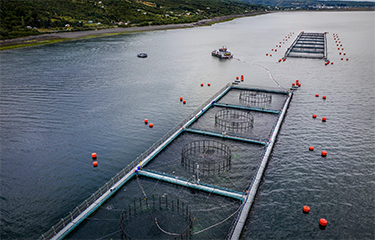Santiago, Chile-based salmon farmer Salmones Camanchaca saw net income after tax of USD 9.7 million (EUR 8.7 million) in Q4 2021, reversing from a net loss of USD 7.5 million (EUR 6.7 million) in the same quarter of 2020, which the company mainly attributed to higher market prices and higher Atlantic salmon sales volume.
The company harvested 15,002 metric tons (MT) whole fish equivalent (WFE) of Atlantic salmon at an average weight of 4.5 kilograms in Q4, down 5.1 percent from the 15,801 MT WFE harvest volume in the same quarter of 2020, when the average weight was 5.6 kilograms, according to information reported to the Oslo bourse. However, a build-up in inventory levels up at the end of 2020 – stemming from lower market prices that were strongly affected by the pandemic – were sold during the year, allowed for an 18 percent year-over-year boost in Q4 sales volume, reaching 16,273 MT WFE.
The average Atlantic salmon sales price jumped 46.6 percent higher during the quarter when compared to Q4 2020, increasing nearly USD 2.00 (EUR 1.80) per kilogram WFE, the company said.
The company's coho harvest volume in Q4 2021 fell 34.7 percent from the same quarter of 2020 to 1,842 MT WFE, which Salmones Camanchaca said was due to it stocking one less farming site, leaving a remaining volume of 663 MT WFE that was harvested in January 2022. Coho salmon sales volume for the quarter dropped to 510 MT WFE, less than half of the 1,092 MT sold in Q4 2020.
Operating revenue for the quarter surged 63.4 percent year-over-year to USD 107.6 million (EUR 96.1 million). Quarterly earnings before interest, taxes, depreciation, and amortization (EBITDA) came in at USD 17.6 million (EUR 15.7 million), compared to a loss of USD 8.8 million (EUR 7.8 million) in Q4 of 2020, thanks to the increased prices and volume.
“We are pleased with the volume recovery and results obtained in this fourth quarter, which shows once again the capabilities of our company, leaving behind the episodes of algae blooms from the beginning of 2021,” Salmones Camanchaca Vice Chair Ricardo García said, referring to the biomass it lost in the first half of 2021. Extraordinary mortality costs during the quarter came to USD 700,000 (EUR 600,000), due to the final settlement from the insurance claim from the Comau Fjord algae bloom paid by its insurers.
Ex-cage farming costs for the quarter were USD 3.95 (EUR 3.52) per kilogram live weight, 14.9 percent higher than the same period last year, due to harvesting sites in the Comau fjord that were affected by the April 2021 algae bloom.
“However, costs were lower than the immediately preceding quarter of USD 4.18 [EUR 3.72] per kilogram live weight, which confirms the improved cost trend,” the company reported.
García touted Salmones Camanchaca’s sustainability, which he said led into the financial field as well. In November 2021, the company rescheduled USD 135 million (EUR 120 million) in revolving credit lines with DNB Bank, Rabobank, and Santander, making it the first salmon company in Chile to ink a sustainability-linked loan that meets the five characteristics outlined by the Loan Market Association (LMA) and the Loan Syndications and Trading Association (LSTA).
“This is also reflected in our outstanding ranking in the Dow Jones Sustainability Index,” he said. “Additionally, we are proud that our company was recognized in the 2022 Sustainability Yearbook of Standard & Poor (S&P) as an Industry Mover, which identifies companies that had outstanding growth in their sustainability management assessment, and where only 50 firms worldwide hold this distinction.”
The company also highlighted its capital increase at the end of 2021, raising USD 23 million (EUR 20 million) to support its 2021-2023 investment plan, driving higher production in sites with lower risk of algae blooms and lack of oxygen. The company said it is working to recover the biomass it lost during the algae bloom of 2021, while also strengthening the overall financial position of the company.
Overall, Salmones Camanchaca harvested 53,000 MT WFE from its core business of Atlantic salmon farming in 2020. The firm has ventured into coho salmon farming, with plans to replace Atlantic salmon at its farming centers in the Los Lagos Region, as it harvests coho before Chile's summer – when the risk of blooms increases due to higher water temperatures.
The company provided guidance of 2022 harvest volume to reach 51,000 to 55,000 MT WFE, broken down into 45,000 to 48,000 MT WFE of Atlantic salmon and 6,000 to 7,000 MT WFE of coho. It previously announced it expects to harvest between 8,000 and 9,000 MT of antibiotic-free salmon annually by 2024, as the company attempts to cater to more discerning markets.
“The global context is favorable for salmon farming, as alternative proteins are under pressure due to their effects on greenhouse gases, and due to the growth on demand for healthy and nutritious proteins with low emissions and little use of water,” García said. “Farmed salmon is a sustainable response to the challenges of feeding the world, using a tiny part of the sea surface, leaving much less carbon footprint, and almost without using fresh water, which are the great challenges of the planet.”
Photo courtesy of Salmones Camanchaca







